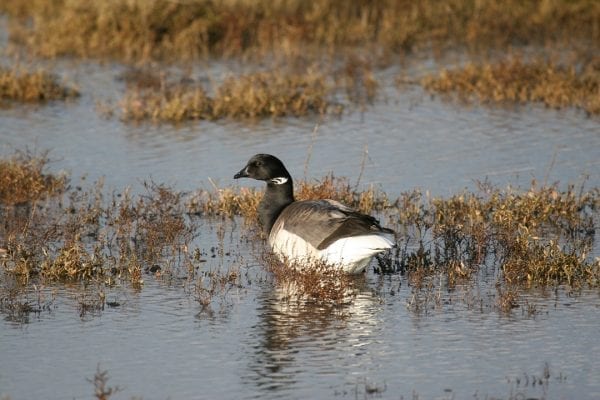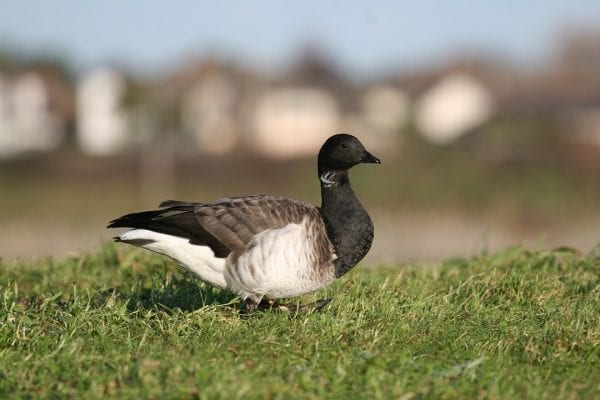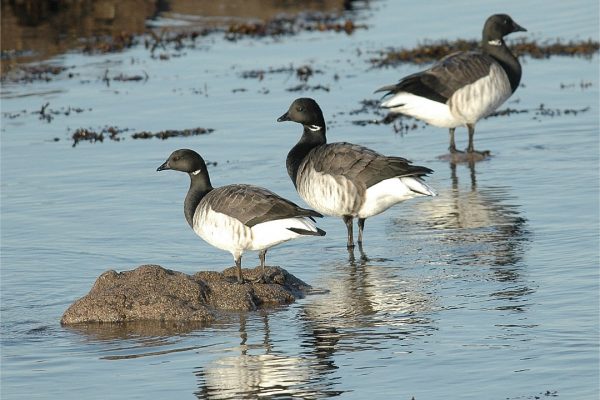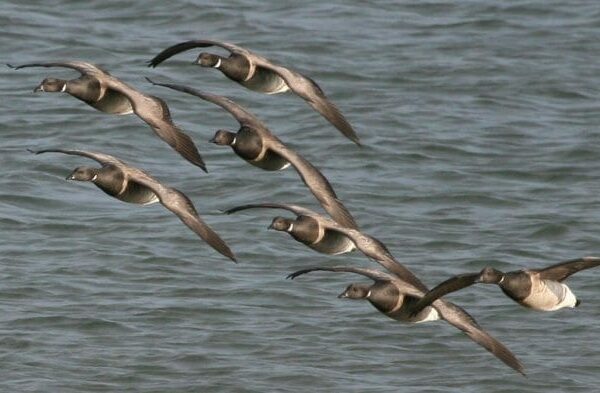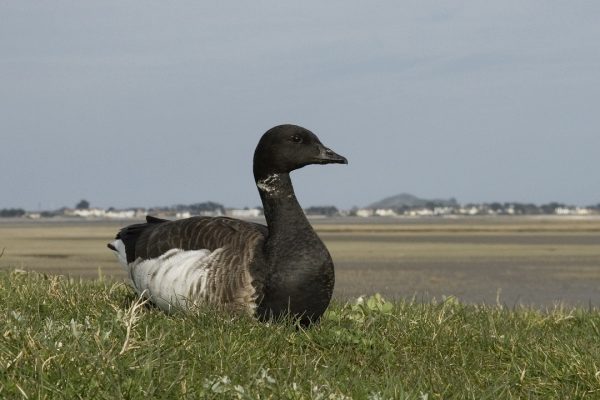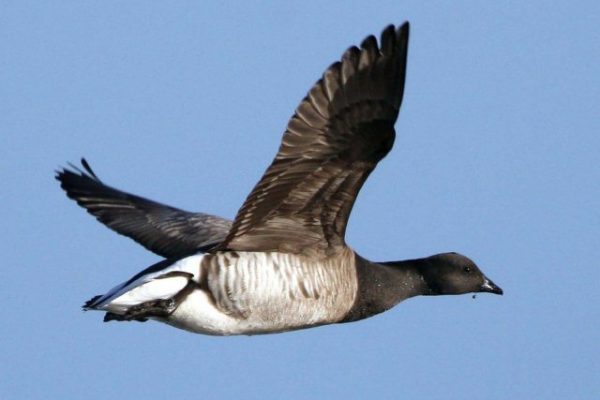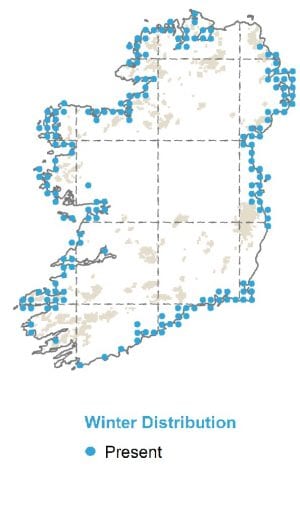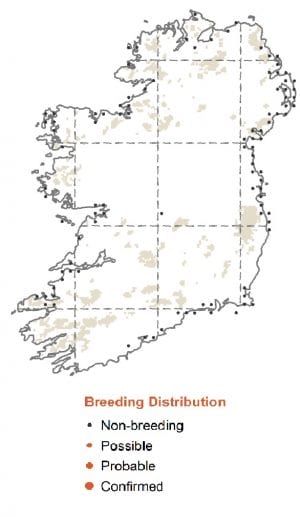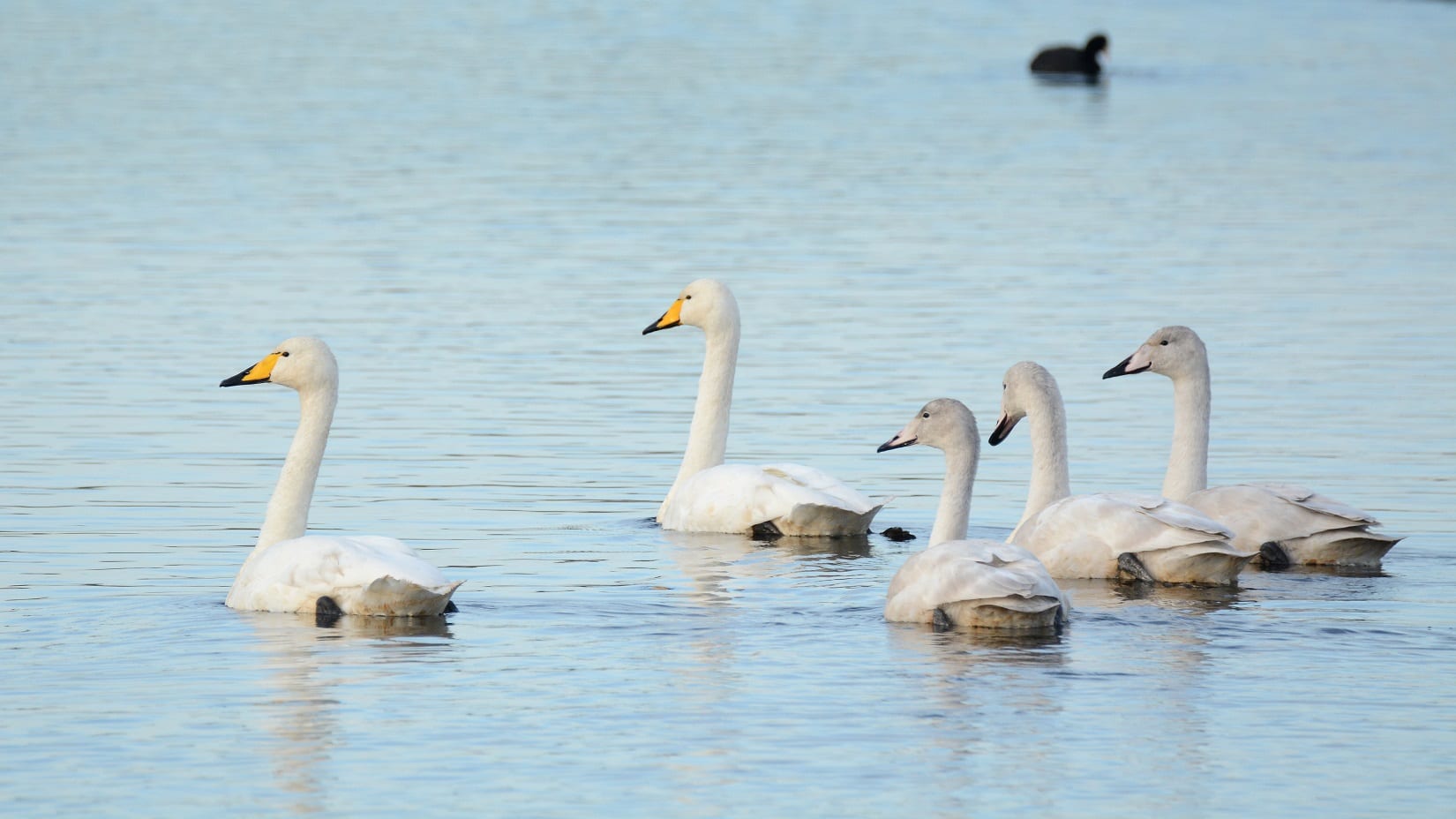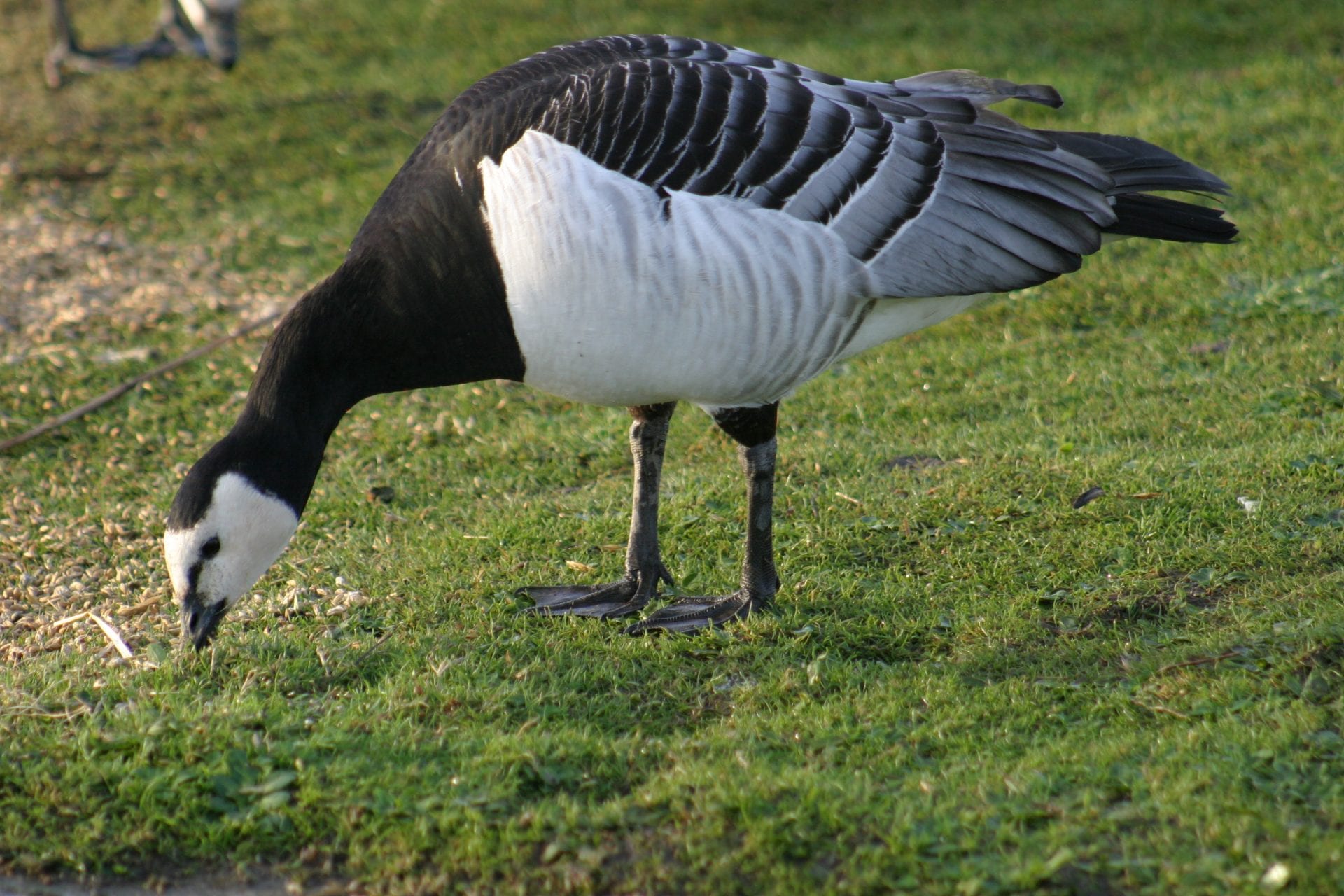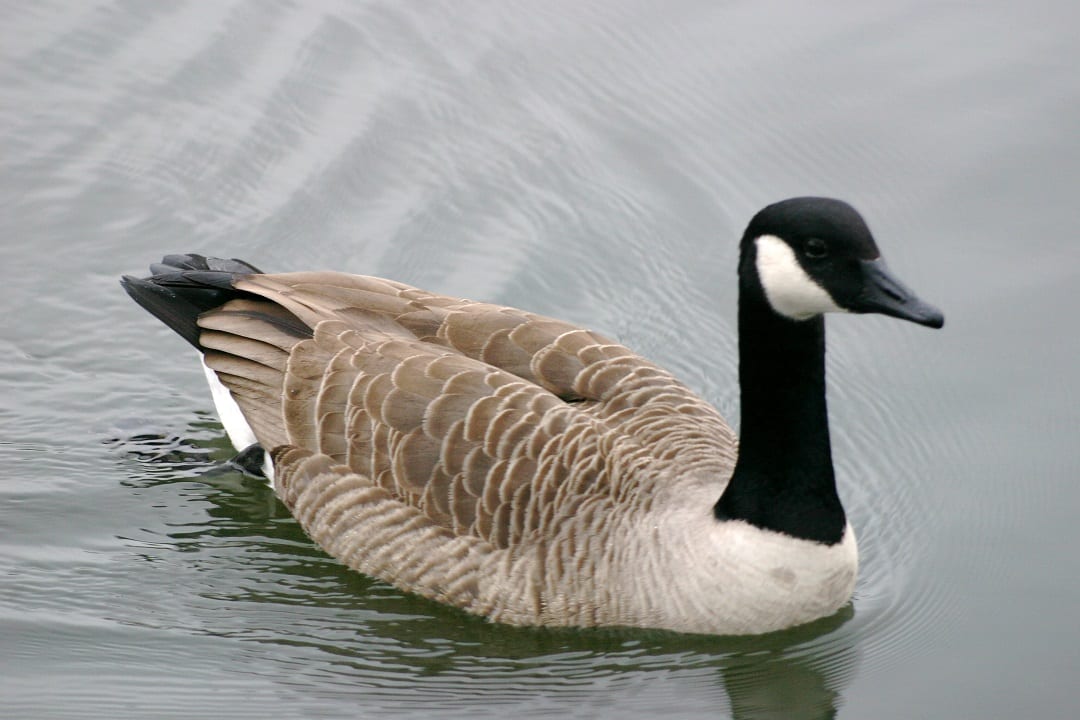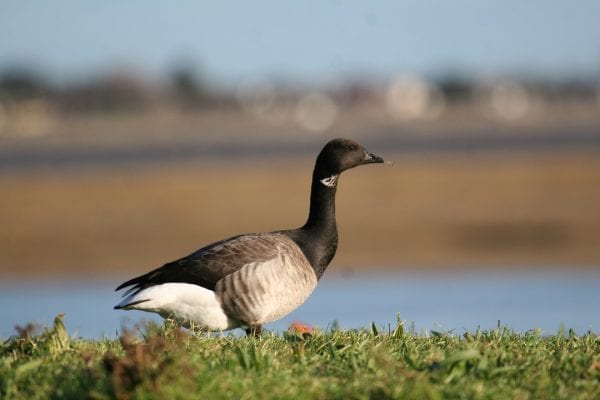
Brent Goose (Light-bellied)
| Irish Name: | Cadhan |
| Scientific name: | Branta bernicla hrota |
| Bird Family: | Geese |
amber
Conservation status
Conservation status
Status
Winter migrant from high-Arctic Canada. Most occur in Ireland between October and April. This population winters almost entirely in Ireland, with small numbers in parts of Britain and France.
Identification
Small dark goose, with a black head, neck and breast, and dark-brown upperparts and pale underparts. Almost whitish flanks, and small white crescent on the upperparts of the neck visible at close range.
Voice
Gutteral 'rhut, rhut'
Diet
During the winter, it feeds mostly on eel-grass, which grows on muddy estuaries, and also on grasslands, usually when coastal supplies have been depleted at estuarine sites.
Breeding
Nests in small, loose colonies by coastal tundra, with pools and small inlets.
Wintering
Mostly found on coastal estuaries during the autumn and early winter, and also on grasslands from mid-winter, until departure for the breeding grounds begins in late April.
Monitored by
Irish Wetland Bird Survey and an annual special survey in October and January each season. In addition, a number of geese have been colour-ringed over the past 10 years and sightings of these can be reported to the Irish Brent Goose Research Group.
Blog posts about this bird
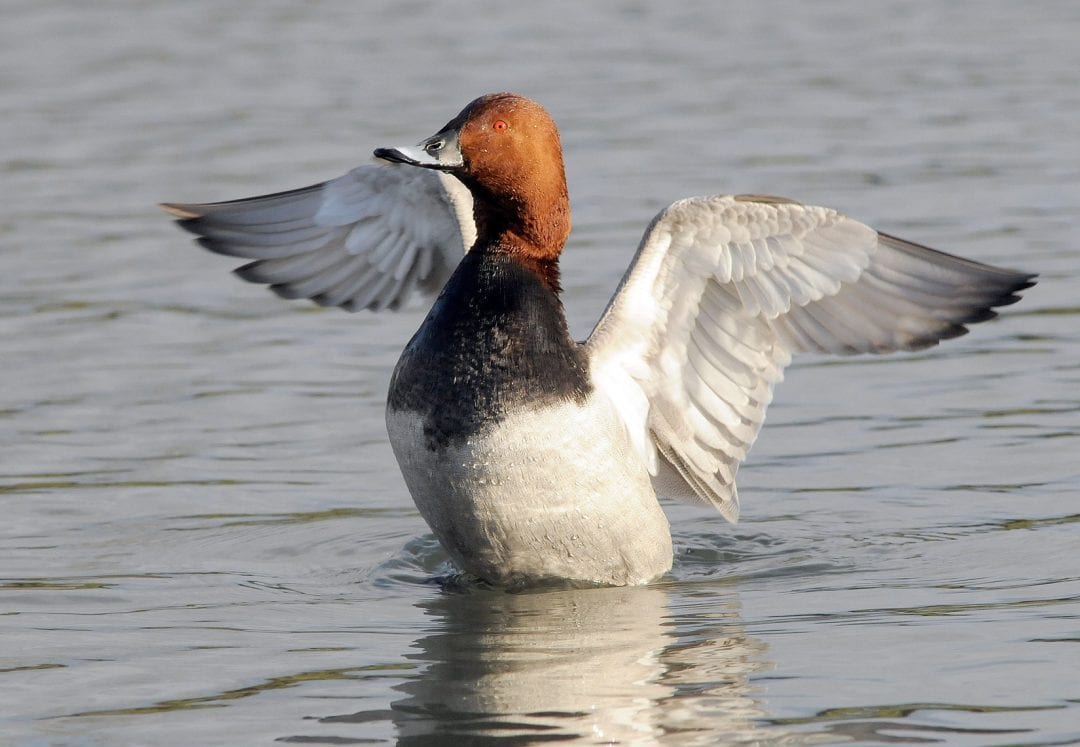
New analysis charts fortunes of wintering waterbirds at a hundred Irish wetlands
The fortunes of Ireland’s wintering waterbird species have been published for 97 lakes, rivers and coastal estuaries across Ireland. You can now see how different species of ducks, waders and other waterbirds are faring at your local wetland, and how that compares to the national trend.
Every winter, hundreds of dedicated bird surveyors count the waterbirds in their locality as part of the Irish Wetland Bird Survey (I-WeBS). The survey,which has been running since 1994, is funded by the National Parks and Wildlife Service (NPWS) and coordinated by BirdWatch Ireland. The winter months see hundreds of thousands of swans, geese, ducks, waders and other waterbirds come to Ireland to escape the freezing conditions in their Arctic breeding grounds. As a result, Irish wetlands are of international importance for a number of species.






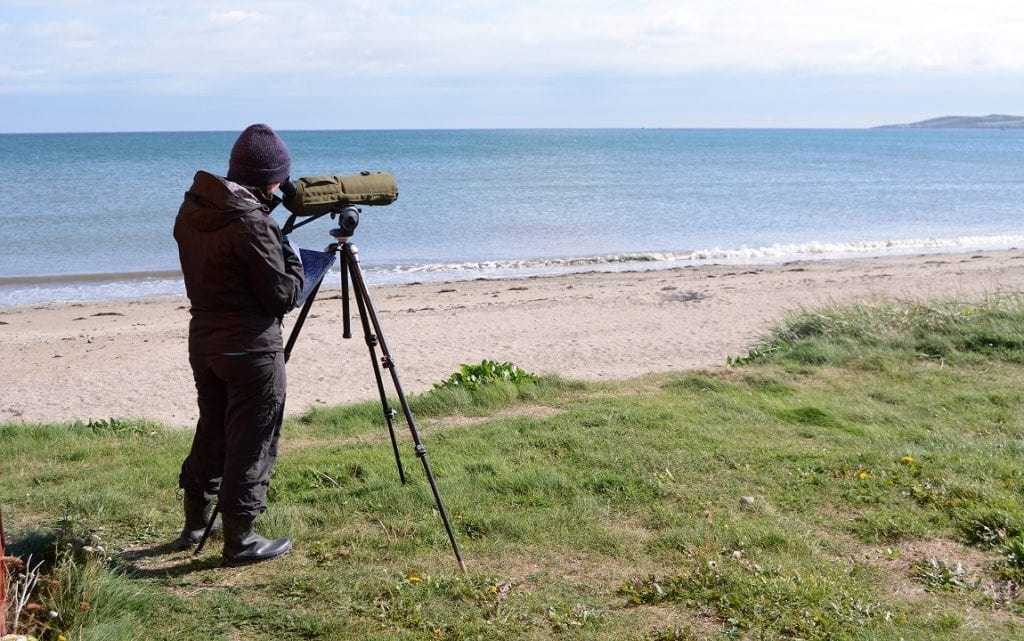
Over a thousand birdwatchers have contributed to I-WeBS since it began in winter 1994/95.
This study focused on 36 wintering waterbird species at 97 of the most closely-monitored wetland sites, spanning 15 counties across Ireland. The extent of increase or decrease for each species at each site was determined. Updated national trends were also produced. While national trends are produced at regular intervals, this is the first time that species trends for individual wetland sites have been published in this way. This information can now be used to better target conservation actions in particular counties and at specific locations and help ensure potential new developments don’t worsen the situation for wildlife in these vitally important areas.The full results of this ‘Waterbird Site Trends’ analysis can be viewed here, including links to view species trends at individual sites.
The new national trends for our wintering waterbirds can be viewed here.
Declines The greatest declines were seen in diving duck species, namely Goldeneye, Pochard and Scaup, which dropped by 65-90% on average since the mid-1990’s, across the 97 sites analysed. Climate change and warming winter temperatures are undoubtedly one of the drivers of these declines, allowing these birds to spend the winter closer to their breeding grounds in northern Europe. At a more local level in Ireland, loss of habitat, changes to water quality, increased disturbance on lakes and in estuaries, and poorly situated developments all worsen the situation, meaning fewer and fewer of these birds return to us each year. Wading birds of the Plover family have also undergone huge declines of over 50%. Lapwing, traditionally referred to as the ‘Green Plover’ or Pilibín and often considered Ireland’s national bird, declined by 64% since the mid-1990’s. Their close relative the Golden Plover, which feeds on grasslands in every county in Ireland in the winter, have declined by a similar amount, as have their rarer coastal relative the Grey Plover. Ireland’s breeding Curlew population is well known to be teetering on the edge of extinction, with only around 100 pairs nesting here in recent summers. Our wintering population is much larger though, as Curlew from northern Europe migrate to Ireland from late summer to early spring, but these birds face similar threats throughout their range. Our wintering Curlew have declined by 43% since the mid-1990’s.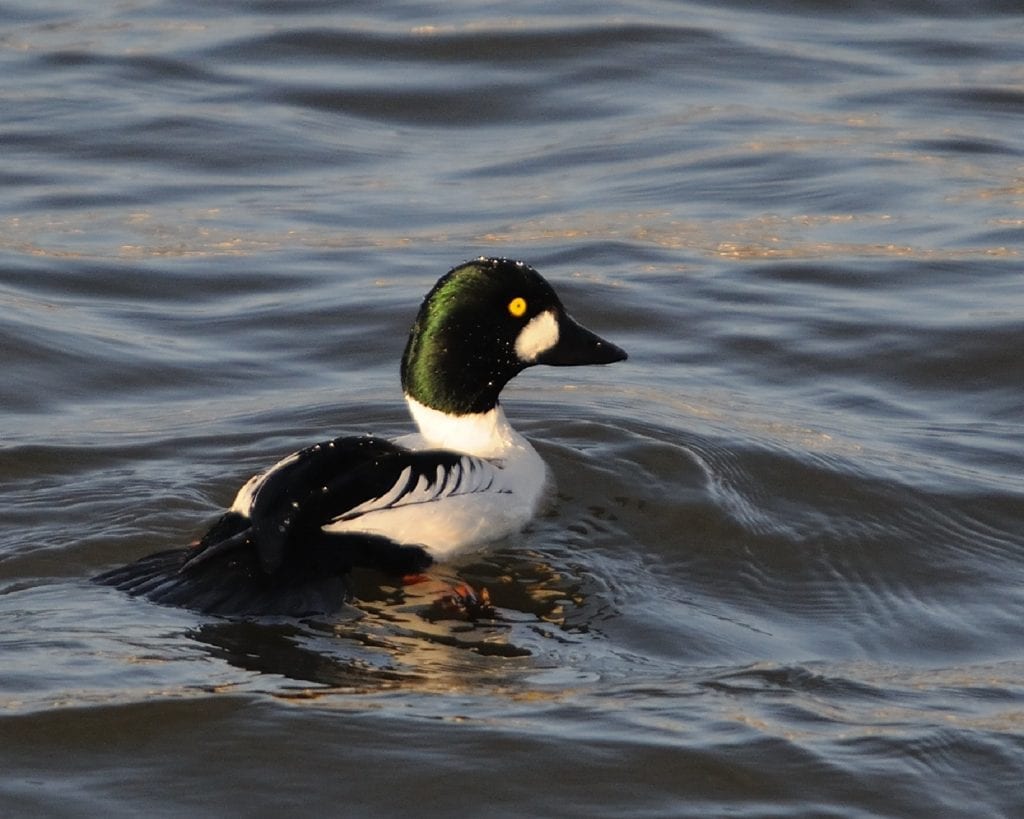
Goldeneye - a diving duck species that has undergone large declines in Ireland.
Health Check “We regularly do this sort of analysis at national level, providing a ‘health check’ to see how Ireland’s wintering waterbirds are doing”, said John Kennedy of BirdWatch Ireland, who led this research “but now we’re delving a bit deeper to see precisely where the problems are. Some species will be showing the same upward or downward trend wherever you look, but there are some wetlands where we see faster declines than we’d expect. That might be because of particular problems at key sites – loss of habitats, changes to water quality, increased disturbance from recreational activities, and similar issues. Equally, there are likely to be places where a species is bucking the national trend and doing very well, and there will be practical lessons to be learned there too.”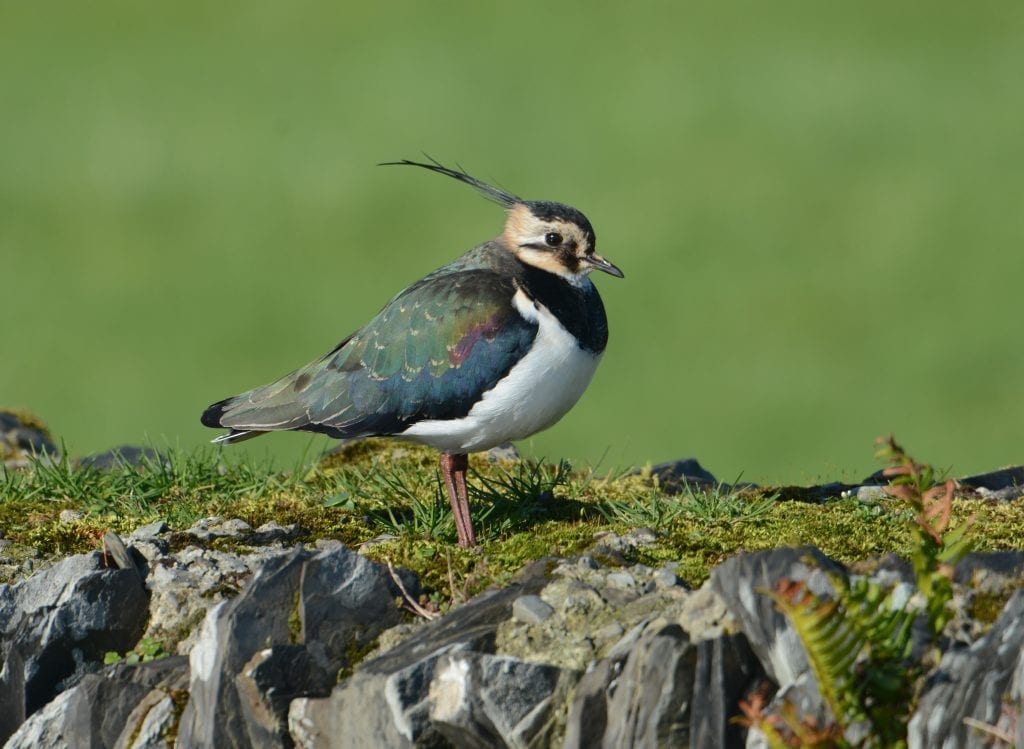
Lapwing is considered by many to be Ireland's national bird, but their declines are cause for concern.
Increases Black-tailed Godwit, a member of the same family as the Curlew that breeds in Iceland, has increased by 92% since annual monitoring began in 1994. Species such as Mute Swan, Little Grebe and Grey Heron, which breed on Irish lakes and rivers are all stable or increasing in number. One of Ireland’s most recent arrivals, the Little Egret, has shown a steady and significant increase since it arrived into Ireland 20 years ago and is now widespread across the entire country. Species with a mixed report card include the Light-bellied Brent Goose, which has increased overall but is now showing a recent decline. Numbers of Sanderling, which the Pixar short movie ‘Piper’ was based on, are 85% higher than they were when monitoring began, but have decreased by 24% in the last five years. Recent declines of this magnitude are cause for concern and there is a risk that longer term increases for some species could be quickly undone in a few short years.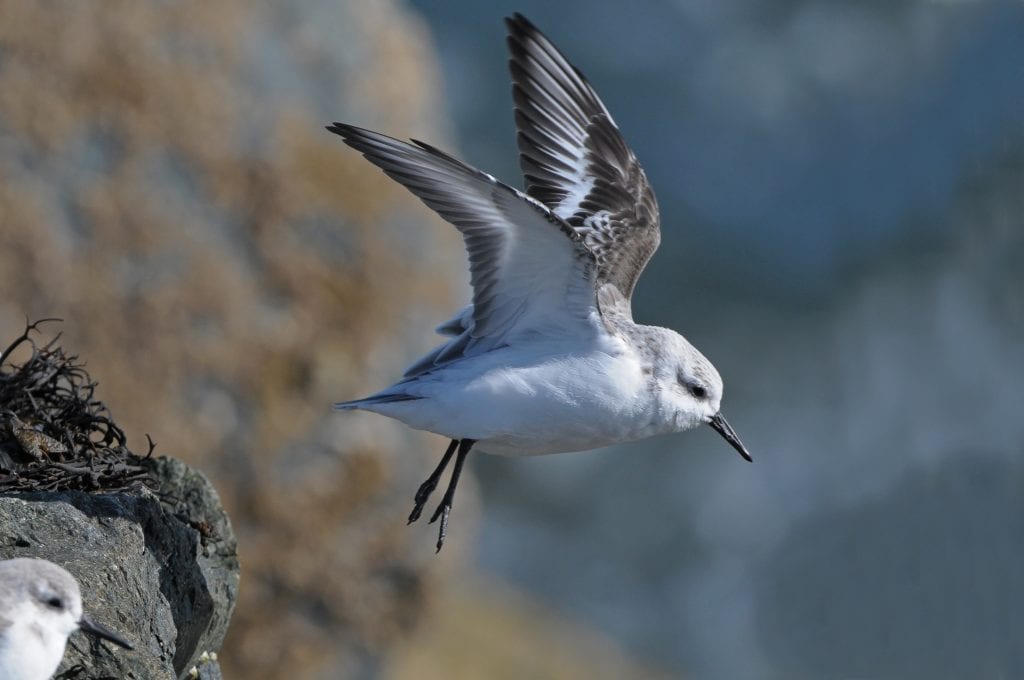
Sanderling have increased overall since monitoring began here, but shown recent declines.
“Ireland’s waterbirds are indicators of the health of the wetland environment they use. These are sites that we depend on too – for drinking water, flood relief, agriculture, tourism, aquaculture and industry. As is always the case with this sort of research, it has answered some questions but poses many more, and we’ll be scrutinising these results in the months and years to come to decipher some patterns of change that might not be so immediately obvious.” Said John Kennedy. Scientific Officer Brian Burke said “We would encourage everyone to visit the website and take a look at how the birds are faring at their local site, and other sites in their county. When you see the numbers side-by-side with the national trend figures, you might be surprised to see how a species is faring closer to home. Of course, the next step is to ensure that these data are used by communities, local authorities and politicians, to protect our precious wetlands and all of the ecosystem benefits they’ve brought us for generations. Since the survey began in 1994, over 1,100 counters from across the country have given up their time to provide this data, amounting to more than 81,000 winter site visits. None of this would be possible without their dedication!”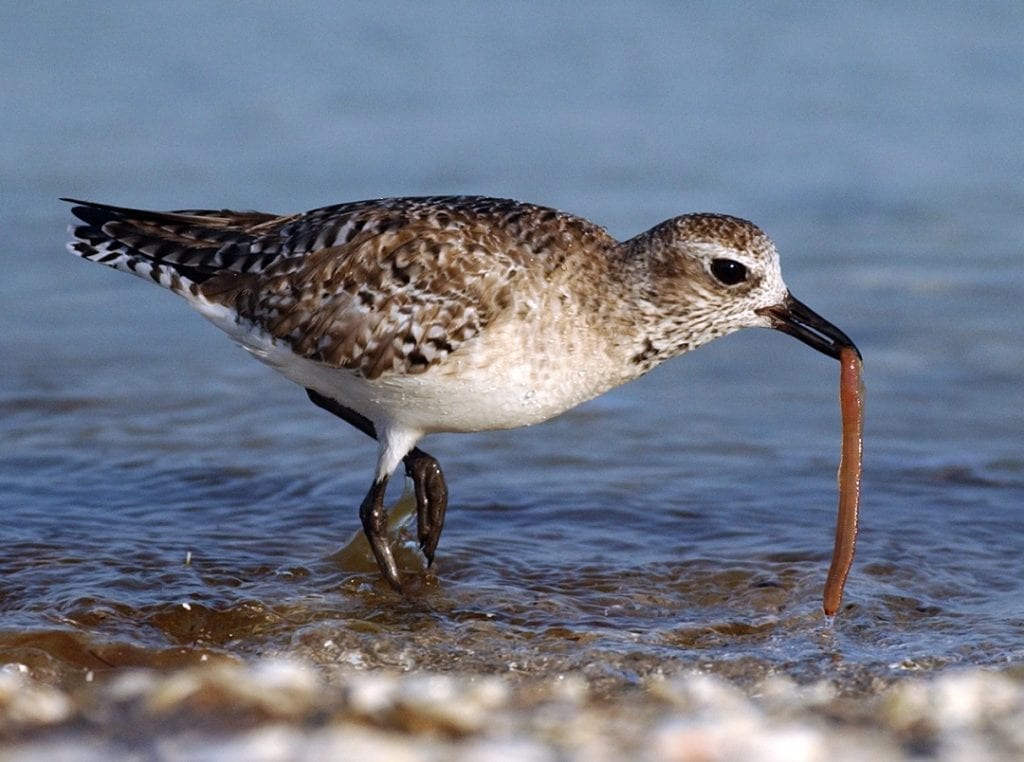
Grey Plover, a strictly coastal version of the more widespread Golden Plover and Lapwing, are faring poorly.
The results are also important in a planning context. I-WeBS Project Manager Lesley Lewis explains “An Appropriate Assessment (AA) is an assessment of the potential adverse effects of a plan or project (in combination with other plans or projects) on Special Areas of Conservation and Special Protection Areas, the latter often designated for migratory wintering waterbirds. These new site trends will therefore allow those completing AA to assess the current status of the waterbird species at the relevant sites. This is an important improvement to the process that will have implications for future developments across the country.” Dr Seán Kelly, waterbird ecologist at the NPWS who manages the I-WeBS contract added: “The Irish Wetland Bird Survey is an incredibly successful and valuable bird monitoring programme. The success of the programme is down to the hundreds of citizen scientists and NPWS and BirdWatch Ireland staff across Ireland who take part in the survey. The size, strength and extent of this bird monitoring community is simply fantastic, and I would like to thank every individual for their ongoing efforts. The survey has been running since 1994 so the resulting long-term dataset allows us to robustly monitor environmental change as it manifests in and impacts upon bird populations. I really encourage everyone to take a look at the report and consider the findings, at a local and national level. The data gathered under this survey allows us to further understand how and where conservation management and policies can be improved.”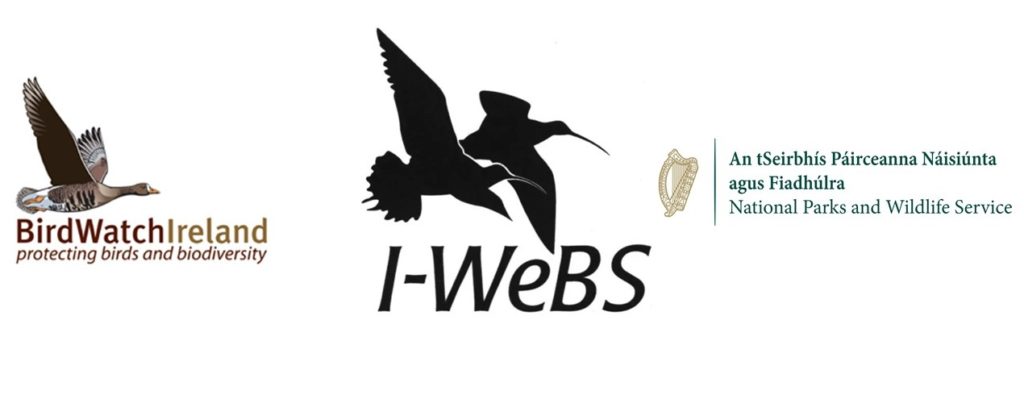
The new national trends for our wintering waterbirds can be viewed here.
Full details about the Irish Wetland Bird Survey can be found here.
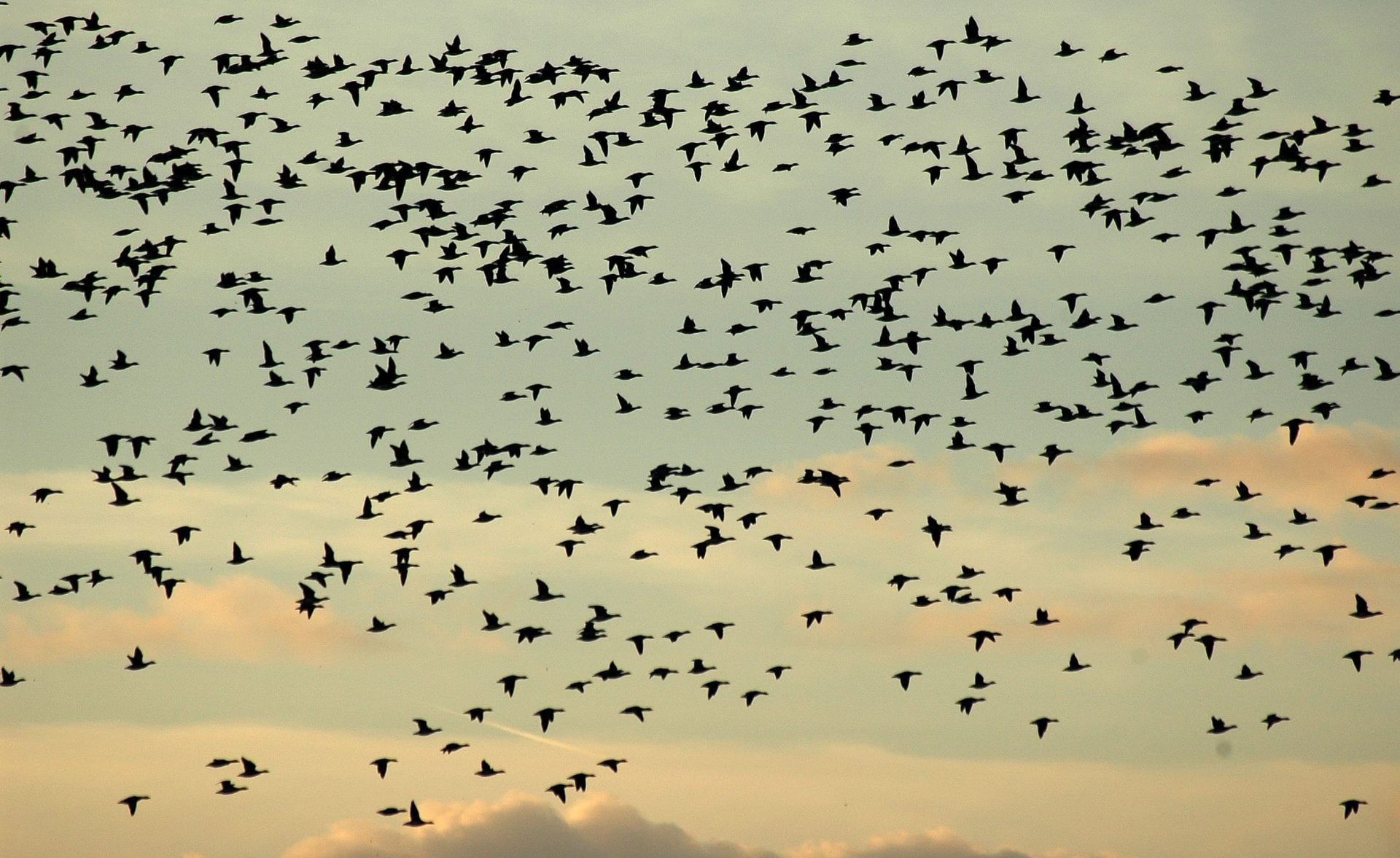
Geese and Swans return to Ireland for the winter
If you haven't noticed the dearth of swifts and swallows around the country recently, then this weeks weather will have put it beyond doubt that the summer is indeed over! When most people think of "birds flying south for the winter" they associate it with a mass exodus of Swallows, Martins, Swifts, Warblers and Terns (amongst others), but don't forget that it also means an influx of over 50 waterbird species from northerly latitudes into Ireland for the winter! In the last few weeks the first reports of our wintering goose and swan species have been filtering in, and here in BirdWatch Ireland we love this time of year!
See below some of the details about our Goose and Swan species that have arrived in Ireland in recent weeks:
 The first Greenland White-fronted Geese of winter 2019/20 arrived on the North Slob in Wexford yesterday (01 October 2019) - four adults and a juvenile.
The Greenland White-fronted Goose is the species on the BirdWatch Ireland logo. If you want to get a good look at this species, make sure you visit Wexford Wildfowl Reserve this winter. Later this month there will be a number of public events for their annual 'Goose Week' and they will also be celebrating the 50th Anniversary of the reserve.
The first Greenland White-fronted Geese of winter 2019/20 arrived on the North Slob in Wexford yesterday (01 October 2019) - four adults and a juvenile.
The Greenland White-fronted Goose is the species on the BirdWatch Ireland logo. If you want to get a good look at this species, make sure you visit Wexford Wildfowl Reserve this winter. Later this month there will be a number of public events for their annual 'Goose Week' and they will also be celebrating the 50th Anniversary of the reserve.
 The first Brent records of 2019 came at the end of August, which isn't actually unusual, though the bulk of birds arrived several weeks later (and are still coming!).
When they first arrive in Ireland they head en mass for Strangford Lough. After refueling there, they gradually disperse around the Irish coast as the winter goes on. Many Brent have already returned to their usual haunts in Donegal, Derry, Louth and Dublin, where they'll feed on eelgrass and algae in the sea, before turning to terrestrial grasslands for a few months before making the return journey back to Canada!
The first Brent records of 2019 came at the end of August, which isn't actually unusual, though the bulk of birds arrived several weeks later (and are still coming!).
When they first arrive in Ireland they head en mass for Strangford Lough. After refueling there, they gradually disperse around the Irish coast as the winter goes on. Many Brent have already returned to their usual haunts in Donegal, Derry, Louth and Dublin, where they'll feed on eelgrass and algae in the sea, before turning to terrestrial grasslands for a few months before making the return journey back to Canada!
 One of the first records in Ireland this year was via the WWT's Kane Brides who informed us of a satellite-tagged bird that arrived from Iceland on the 4th of September, spending a couple of hours in Roscommon before heading to Carlingford Lough on the east coast that night.
Small numbers of Pink-footed Geese winter in Ireland, but hundreds of thousands winter in the UK and stop in Ireland en route from their Icelandic breeding grounds. Since the start of September there have been loads of Pink-foots (Pink-feets?!) spotted in Donegal and smaller flocks in Wexford, Louth and Dublin.
One of the first records in Ireland this year was via the WWT's Kane Brides who informed us of a satellite-tagged bird that arrived from Iceland on the 4th of September, spending a couple of hours in Roscommon before heading to Carlingford Lough on the east coast that night.
Small numbers of Pink-footed Geese winter in Ireland, but hundreds of thousands winter in the UK and stop in Ireland en route from their Icelandic breeding grounds. Since the start of September there have been loads of Pink-foots (Pink-feets?!) spotted in Donegal and smaller flocks in Wexford, Louth and Dublin.
 In the last few days there have been multiple reports of large flocks of Greylag Geese at coastal sites in Donegal.
Greylags are a tricky one - we have a resident population that breeds here, but we also get migrants from Iceland for the winter too. And there's no way to tell which is which in the field as they look the exact same! Donegal has many feral/naturalised Greylag Geese, but some of those recent large flocks probably have some Icelandic-migrants mixed in too.
Barnacle Geese
In the last few days there have been multiple reports of large flocks of Greylag Geese at coastal sites in Donegal.
Greylags are a tricky one - we have a resident population that breeds here, but we also get migrants from Iceland for the winter too. And there's no way to tell which is which in the field as they look the exact same! Donegal has many feral/naturalised Greylag Geese, but some of those recent large flocks probably have some Icelandic-migrants mixed in too.
Barnacle Geese
 The first 'Barnies' of the season touched down in Donegal at the start of this week.
This species prefers coastal grasslands and offshore islands in the west and north-west. Because of the remote locations they use, the NPWS recently carried out a Barnacle Goose census by plane!
The first 'Barnies' of the season touched down in Donegal at the start of this week.
This species prefers coastal grasslands and offshore islands in the west and north-west. Because of the remote locations they use, the NPWS recently carried out a Barnacle Goose census by plane!
Whooper Swan
The first definite migrants have only appeared in recent days - in Donegal, Derry and today in Wexford.
In the last census, there were nearly 12,000 Whooper Swans in ROI and >3,500 in NI. The I-WeBS office in BirdWatch Ireland, together with our colleagues in Northern Ireland and further afield, will be coordinating another census of Whooper Swans in January 2020 so please keep an eye on your local flock as the winter progresses!
So there you have it - thousands of geese and swans are currently migrating from Iceland, Greenland and Canada to spend the winter in Ireland! Many of these species are of conservation concern and we're lucky to have the wetlands to support them, so do keep an eye out for them in your area as the winter goes on!
Greenland White-fronted Goose
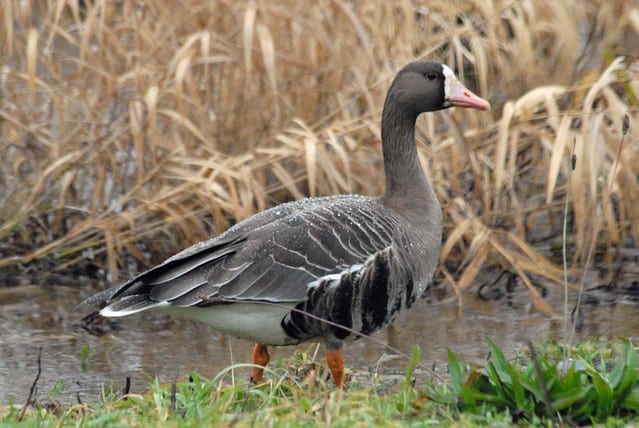 The first Greenland White-fronted Geese of winter 2019/20 arrived on the North Slob in Wexford yesterday (01 October 2019) - four adults and a juvenile.
The Greenland White-fronted Goose is the species on the BirdWatch Ireland logo. If you want to get a good look at this species, make sure you visit Wexford Wildfowl Reserve this winter. Later this month there will be a number of public events for their annual 'Goose Week' and they will also be celebrating the 50th Anniversary of the reserve.
The first Greenland White-fronted Geese of winter 2019/20 arrived on the North Slob in Wexford yesterday (01 October 2019) - four adults and a juvenile.
The Greenland White-fronted Goose is the species on the BirdWatch Ireland logo. If you want to get a good look at this species, make sure you visit Wexford Wildfowl Reserve this winter. Later this month there will be a number of public events for their annual 'Goose Week' and they will also be celebrating the 50th Anniversary of the reserve.
Light-bellied Brent Goose
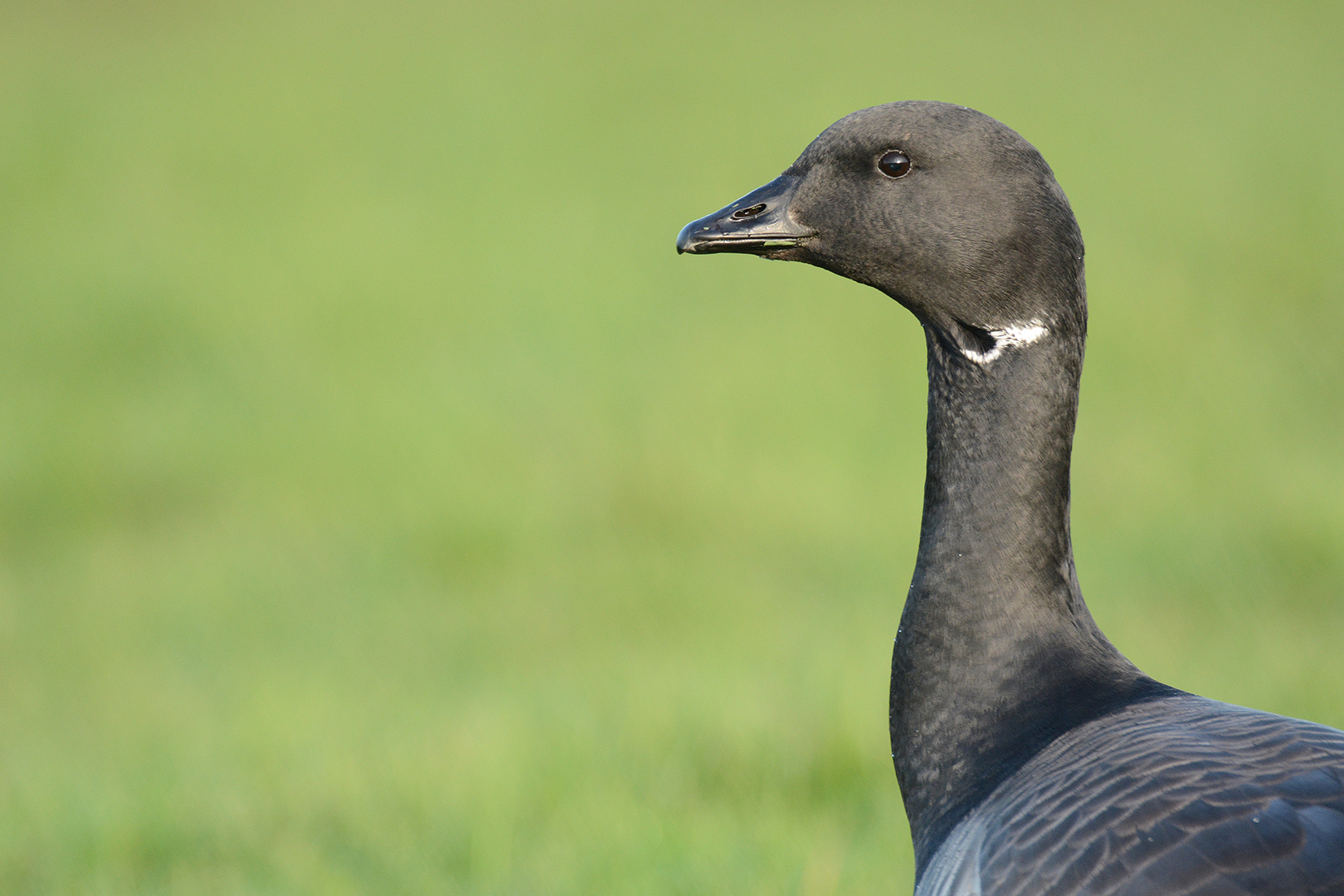 The first Brent records of 2019 came at the end of August, which isn't actually unusual, though the bulk of birds arrived several weeks later (and are still coming!).
When they first arrive in Ireland they head en mass for Strangford Lough. After refueling there, they gradually disperse around the Irish coast as the winter goes on. Many Brent have already returned to their usual haunts in Donegal, Derry, Louth and Dublin, where they'll feed on eelgrass and algae in the sea, before turning to terrestrial grasslands for a few months before making the return journey back to Canada!
The first Brent records of 2019 came at the end of August, which isn't actually unusual, though the bulk of birds arrived several weeks later (and are still coming!).
When they first arrive in Ireland they head en mass for Strangford Lough. After refueling there, they gradually disperse around the Irish coast as the winter goes on. Many Brent have already returned to their usual haunts in Donegal, Derry, Louth and Dublin, where they'll feed on eelgrass and algae in the sea, before turning to terrestrial grasslands for a few months before making the return journey back to Canada!
Pink-footed Goose
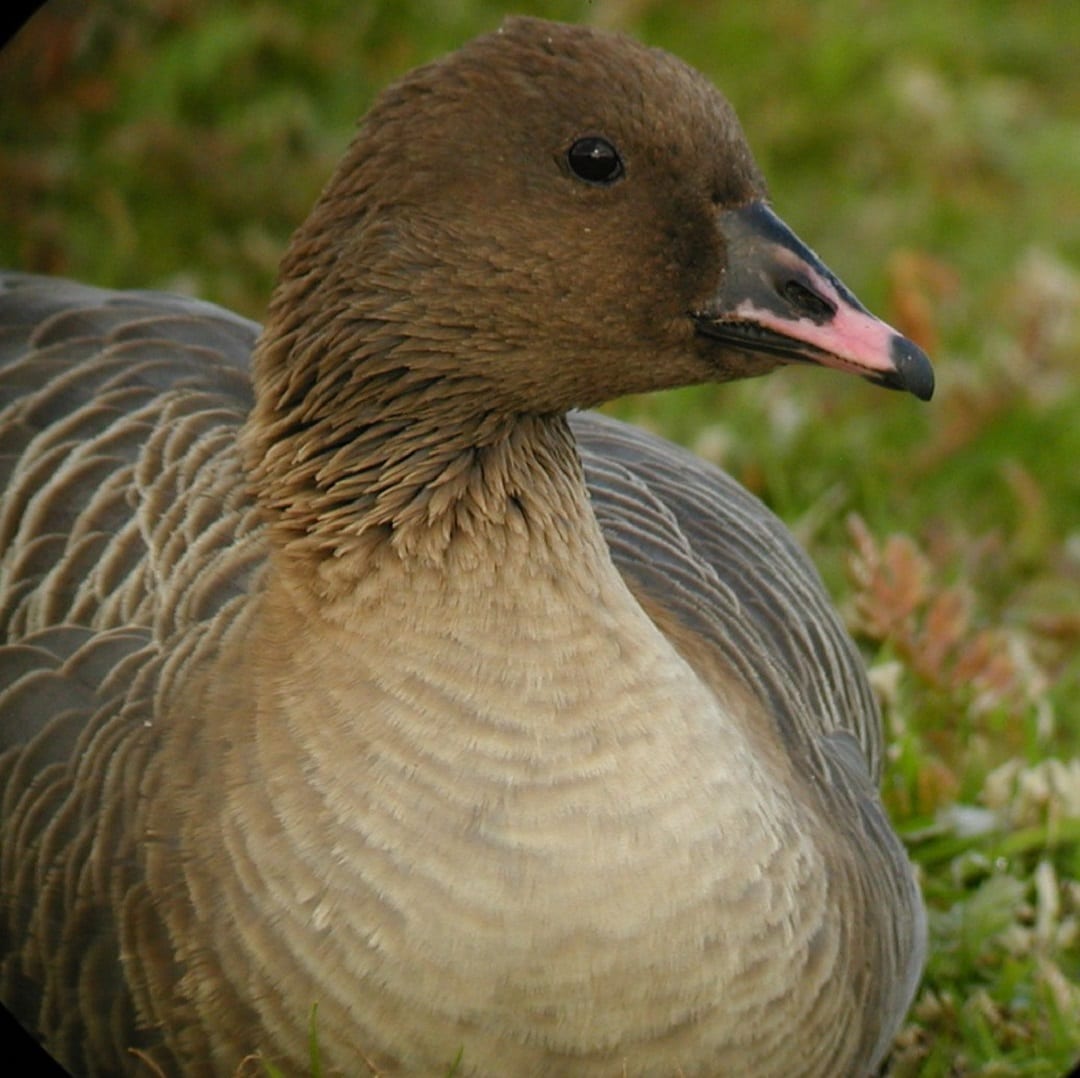 One of the first records in Ireland this year was via the WWT's Kane Brides who informed us of a satellite-tagged bird that arrived from Iceland on the 4th of September, spending a couple of hours in Roscommon before heading to Carlingford Lough on the east coast that night.
Small numbers of Pink-footed Geese winter in Ireland, but hundreds of thousands winter in the UK and stop in Ireland en route from their Icelandic breeding grounds. Since the start of September there have been loads of Pink-foots (Pink-feets?!) spotted in Donegal and smaller flocks in Wexford, Louth and Dublin.
One of the first records in Ireland this year was via the WWT's Kane Brides who informed us of a satellite-tagged bird that arrived from Iceland on the 4th of September, spending a couple of hours in Roscommon before heading to Carlingford Lough on the east coast that night.
Small numbers of Pink-footed Geese winter in Ireland, but hundreds of thousands winter in the UK and stop in Ireland en route from their Icelandic breeding grounds. Since the start of September there have been loads of Pink-foots (Pink-feets?!) spotted in Donegal and smaller flocks in Wexford, Louth and Dublin.
Greylag Geese
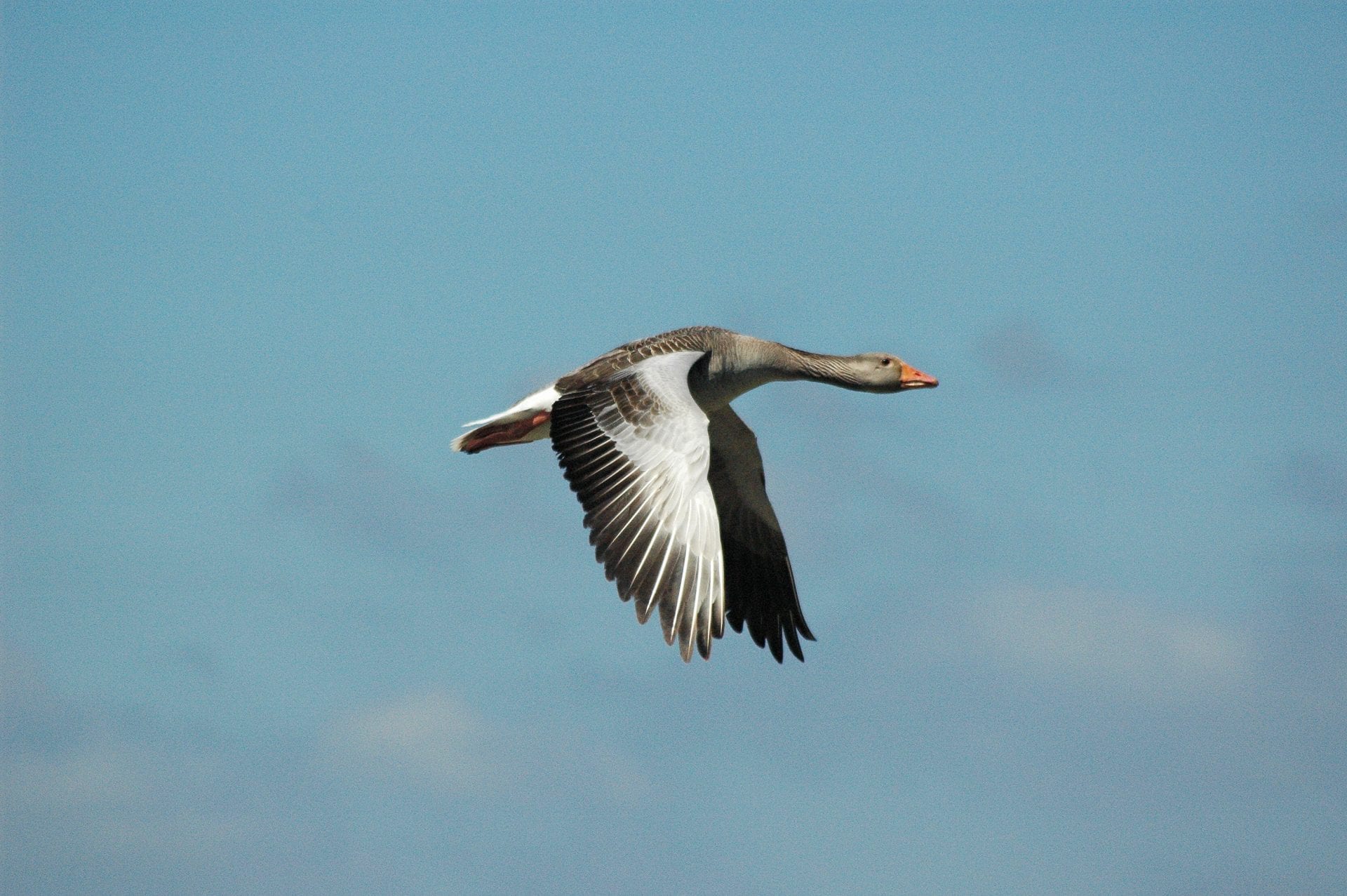 In the last few days there have been multiple reports of large flocks of Greylag Geese at coastal sites in Donegal.
Greylags are a tricky one - we have a resident population that breeds here, but we also get migrants from Iceland for the winter too. And there's no way to tell which is which in the field as they look the exact same! Donegal has many feral/naturalised Greylag Geese, but some of those recent large flocks probably have some Icelandic-migrants mixed in too.
Barnacle Geese
In the last few days there have been multiple reports of large flocks of Greylag Geese at coastal sites in Donegal.
Greylags are a tricky one - we have a resident population that breeds here, but we also get migrants from Iceland for the winter too. And there's no way to tell which is which in the field as they look the exact same! Donegal has many feral/naturalised Greylag Geese, but some of those recent large flocks probably have some Icelandic-migrants mixed in too.
Barnacle Geese
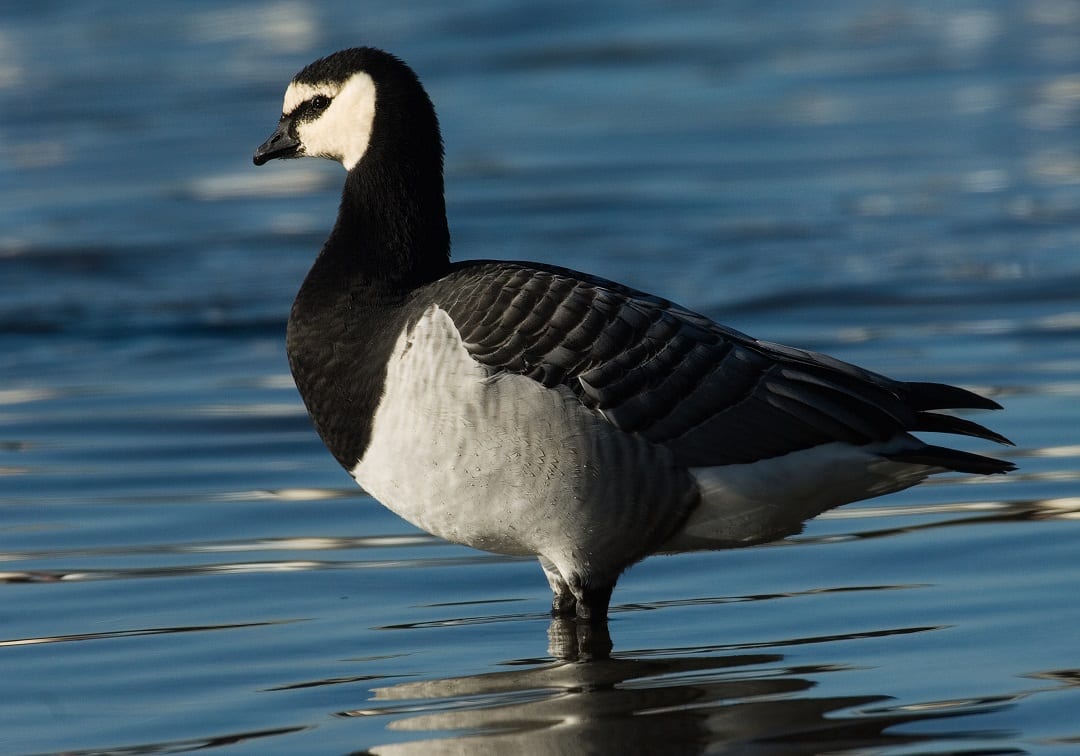 The first 'Barnies' of the season touched down in Donegal at the start of this week.
This species prefers coastal grasslands and offshore islands in the west and north-west. Because of the remote locations they use, the NPWS recently carried out a Barnacle Goose census by plane!
The first 'Barnies' of the season touched down in Donegal at the start of this week.
This species prefers coastal grasslands and offshore islands in the west and north-west. Because of the remote locations they use, the NPWS recently carried out a Barnacle Goose census by plane!
Whooper Swan
The first definite migrants have only appeared in recent days - in Donegal, Derry and today in Wexford.
In the last census, there were nearly 12,000 Whooper Swans in ROI and >3,500 in NI. The I-WeBS office in BirdWatch Ireland, together with our colleagues in Northern Ireland and further afield, will be coordinating another census of Whooper Swans in January 2020 so please keep an eye on your local flock as the winter progresses!
So there you have it - thousands of geese and swans are currently migrating from Iceland, Greenland and Canada to spend the winter in Ireland! Many of these species are of conservation concern and we're lucky to have the wetlands to support them, so do keep an eye out for them in your area as the winter goes on!
Each winter we monitor Ireland's waterbird populations through I-WeBS - a survey coordinated by BirdWatch Ireland, funded by the National Parks and Wildlife Service, and carried out by a network of bird surveyors who volunteer their time and expertise.
The I-WeBS office is interested in any records of Greylag or Pink-footed Geese this winter - please email us at iwebs@birdwatchireland.ie with numbers, locations and dates.
The website 'IrishBirding' was also a useful source for this article.

